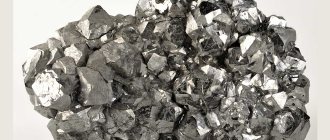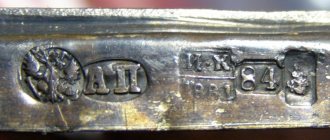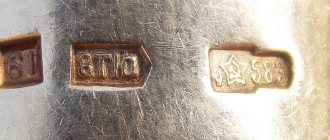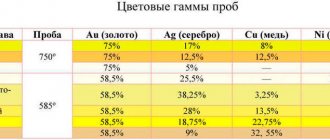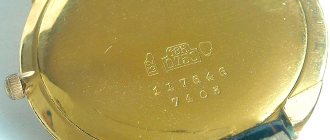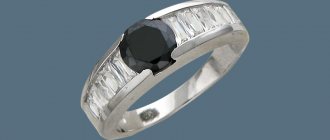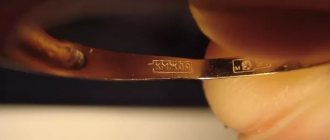Thanks to its natural physical and chemical characteristics, gold has found application in many areas: jewelry industry, chemical industry, medicine, dentistry, etc. Pure precious metal is soft and ductile, which is why it loses its jewelry value. Manufacturers use an alloy of different metals, which increase strength and durability, improving the consumer properties of products.
The ligature composition is very diverse and determines a wide range of gold products.
Ligature and ligature gold - what it is, auxiliary alloys, what it relates to
Most mined metals initially contain unnecessary components. After the reserves are extracted from the earth's crust, the raw materials are processed for further transportation. Dore alloy is made from mined ore that is saturated with different elements. This form allows the future noble metal to undergo refining at specialized plants, where it is purified from impurities.
Pure precious metal itself is quite plastic, which is why it is not suitable for making various items.
However, ligature gold is highly valued by jewelers. By adding other elements, you can change the physical properties of precious metals, improve their wear resistance and appearance.
Alloys of various compositions are used
to solder ligature gold . Ligature involves mixing pure metals with each other, without any impurities. Several purified components can be added to a precious metal at the same time: copper, platinum, silver. The composition is durable and malleable, which is important in the manufacture of jewelry.
In jewelry
In jewelry, a ligature is added to a precious metal to bring the jewelry alloy to a certain standard, to change the color of the alloy, and also to give it various useful properties:
- Increasing the hardness and wear resistance of the metal. Necessary for long-term use of the product.
- Improving malleability, casting properties, increasing/decreasing the melting temperature of the alloy for ease of processing of products by a jeweler.
For gold, the alloy usually consists of silver and copper; platinum, palladium, nickel and zinc are less commonly added.
In silver, the alloying component is copper.
The historical fact of the appearance of ligatures in the monetary system
The physical characteristics of the noble metal became the reason for the search for methods to increase the hardness of gold back in the Middle Ages. Coins made from pure precious metal lost weight and became deformed over time. Then a ligature for gold appeared in the monetary system, which made it possible to prevent the erasure of coins due to the addition of non-ferrous metals.
Gold bars
This decision caused differences between the images on the coins and their actual composition. This difference began to be noticed by the “money changers” of that time, who checked the authenticity of the coins by rubbing them on a mat. Money made of pure gold shrank, lost weight, and the mat accumulated a large amount of the noble metal.
Gradually, the full-value coins in circulation ran out, leaving only the inferior ones. Old means of payment have depreciated.
Jewelry alloys
Pure gold and pure silver are very soft metals, but the alloy of these metals unexpectedly acquires a higher hardness than either of them alone. In addition, it is more ductile, has better malleability than parent metals, and melts at a lower temperature. Those. adding silver to gold improves its properties from a jewelry point of view. Copper and a number of other metals, called base metals, have a similar quality in relation to gold and silver.
The addition of a small amount of silver to gold makes the alloy pale yellow, but if you take gold and silver in equal parts, the yellowness completely disappears. An alloy of gold and copper, on the contrary, looks reddish: copper adds brightness to the noble metal. Therefore, for the jewelry industry, an alloy containing silver and copper is used to obtain a beautiful noble gold hue and high hardness of gold.
Often gold deposits are mined already fused with silver. Such a native alloy containing 45% gold is called electrum. At gold mining enterprises, metals are separated in order to then create various alloys with precisely taken proportions and pre-known properties.
Metals that determine the color of gold
The color directly depends on the composition of the jewelry and the proportion of impurities:
- white shade of sample 585 - the result of an alloy with the base metal of nickel, palladium, platinum, silver, the proportion of noble metal is approximately 59%;
- the red tone is given by the composition of copper;
- the yellow tint of the product is characteristic of pure metal with a slight addition of silver or copper;
- the purple tint is the result of mixing 750 grade precious metal with aluminum;
- black color: alloying metals are ruthenium, chromium, cobalt;
- a green tint is obtained by adding silver and rubidium.
585 white gold
The sample is the same, but the color of gold is different
Products of different colors may have the same sample due to impurities. The proportion of the base metal remains unchanged, only the proportions of the alloys change. The lack of bright shine in the jewelry may indicate the presence of nickel among the components. By adding copper, you can get yellowish tints.
The amount of impurities not only allows you to diversify the color range, but also significantly enhance the strength of the material, as well as provide it with protection from external influences.
Gold of different shades
Palladium and platinum are precious alloys that increase the value of a gold product
The most expensive precious metal admixtures are platinum and palladium. Such a gold ligature is not available to every buyer due to the high cost of jewelry. The price of such a composition significantly exceeds the cost of an item made from other precious metals and is equal to items made from pure noble metal.
The difference between white gold and silver jewelry
Despite the external similarity, there are several differences by which you can find out whether the product is silver or gold
- Try. For silver jewelry it is 925. White gold is found in stores only 585 or 750.
- Gold items are significantly harder than silver items.
- Silver does not shine as brightly as white gold.
A ligature in gold allows you to completely change the properties of the metal, making it possible to obtain real masterpieces. It is thanks to the chemical properties of various alloys that today everyone can find jewelry to suit their taste.
TOP - 4 systems for measuring gold purity
- Zolotnikovaya. It belongs to the outdated measurement systems of the USSR and is practically not used today. The basis is the Russian pound, consisting of 96 spools.
- Metric. Buyers most often encounter this system. The hallmark on jewelry indicates the proportion of gold in the alloy. This indicator helps determine how high quality the product is. The cost depends on the sample.
- Carat. Indicates the gold portion in carat ratio. Applies to Western Europe and North America. In essence, it resembles the metric measurement system.
- Lotovaya. A system for measuring fineness for gold, which was used in Germany until 1888. Using the system, it was possible to determine the number of gold lots in the existing 16.
Sample 56 on a gold ring
general information
Anyone who has ever bought jewelry has noticed that the hallmark indicates in numbers the exact amount of pure gold in the jewelry. Responsible manufacturers place an additional stamp next to the sample, which is called a name tag. Information that can be found from the name, year of manufacture, territorial inspection, individual manufacturer code.
In turn, samples are divided into three measurement systems:
- metric;
- carat;
- spool valve
Buyers more often deal with the metric three-digit system, which indicates the amount of precious metal per kilogram of alloy. During the Soviet era, jewelry of 585 standard was present on the shelves of jewelry stores, where the percentage of other components was 41.7%. Today, such a ratio is very rare, and the most popular is gold 585 alloy. Products with this indicator have excellent performance properties and look great.
Ligature is an alloy that changes the color of a precious metal.
Table: sample ratio between systems
| Piece of pure precious metal | Metric system, standard | Carat system, carat |
| 99,9% | 999 | 24 |
| 95,8% | 958 | 23 |
| 75% | 750 | 18 |
| 58,5% | 585 | 14 |
| 58,3% | 583 | 14 |
| 50% | 500 | 12 |
| 37,5% | 375 | 9 |
Understanding platinum
Platinum is a precious metal that visually resembles silver. However, this is only the first similarity, which will not be difficult to distinguish. Silver has a warm tint, while platinum is rewarded with a noble white color. Comparing platinum with white gold is not entirely correct, because in fact, white gold has a quite noticeable warm undertone, which is neutralized by the top protective coating of rhodium or ruthenium. Yes, it is possible to alloy white gold without a pronounced warm tint, but in practice this alloy is practically not used.
The minimum purity of platinum does not fall below 850, although the metal usually has an even higher value. The favorite standard of BENSES jewelers is 950 platinum.
Platinum products are more expensive than gold, but few people know why. The opinion has been established that gold is simply cheaper, but in reality this is not entirely true. The initial cost of pure metals per gram is approximately the same, sometimes even platinum can be cheaper. The difference begins to be felt the moment the jewelers get to work.
Read also: Do you need an aerator on the roof?
The 950 platinum alloy is significantly heavier than the 585 gold alloy. To be precise, platinum weighs 21 grams per cubic centimeter, while for gold this figure varies from 13 to 15 grams per cubic centimeter. Weight fluctuations are determined by the ligature.
Accordingly, in two visually similar products made of gold and platinum, the share of the precious metal itself differs significantly. Platinum is required almost twice as much as gold, and the final weight of a platinum product is significantly higher than the weight of gold jewelry. Hence the price difference.
Platinum, with its complex white hue, pairs perfectly with precious stones. The peculiarities of the metal allow you to securely fasten even high-carat stones without fear for the safety of fastening. We use copper, indium and gallium as alloys. When BENDES jewelers need to achieve maximum hardness, we add white gold. Depending on the percentage combination of precious metals, a certain standard is set on the jewelry.
In Russia you can find 850, 900, 950 or 999 platinum.
Imported ligature gold plated price per kg
Most often, foreign jewelry differs from domestic samples. In their composition, the proportion of alloys exceeds the amount of noble metals. American and European standards have a certain similarity with Russian ones, but the hallmark is affixed in carats. You can often buy a fake with a precious coating.
Abroad, low-karat gold is very popular for making jewelry, due to its more suitable consumer characteristics. 9-12 carats are much stronger and harder, they are characterized by high resistance to deformation and scratches. In Russia, products with a lower proportion of impurities are more popular: the higher the standard, the greater the demand.
Ligature with gilding imported
Turkish gold is stamped with three numbers 585. No other designations are provided. A large proportion of the alloy is copper, which can be determined by the excessive redness of the products. Gilded silver items are often passed off as jewelry. Jewelry becomes dull and deformed over time. However, purchases remain at a high level due to the affordable price.
There are also Emirati jewels. They contain a minimal proportion of ligature. Only 2 samples are used: 916 and 958. Jewelry is short-lived, so in the country it is customary to wear them only for weddings. Then the jewelry is simply stored in boxes.
Excerpt characterizing Ligature (metallurgy)
“They told me that you ordered a pawn,” she said, out of breath (she was apparently running), “and I really wanted to talk to you alone.” God knows how long we will be separated again. Aren't you angry that I came? “You have changed a lot, Andryusha,” she added, as if to explain such a question. She smiled, pronouncing the word “Andryusha”. Apparently, it was strange for her to think that this stern, handsome man was the same Andryusha, a thin, playful boy, a childhood friend. -Where is Lise? – he asked, only answering her question with a smile. “She was so tired that she fell asleep in my room on the sofa. Ax, Andre! Que! tresor de femme vous avez, [Ax, Andrey! What a treasure your wife is,” she said, sitting down on the sofa opposite her brother. “She’s a perfect child, such a sweet, cheerful child.” I loved her so much. Prince Andrei was silent, but the princess noticed the ironic and contemptuous expression that appeared on his face. – But one must be lenient towards small weaknesses; who doesn't have them, Andre! Don't forget that she was brought up and grew up in the world. And then her situation is no longer rosy. You have to put yourself in everyone's position. Tout comprendre, c'est tout pardonner. [Whoever understands everything will forgive everything.] Think about what it must be like for her, poor thing, after the life to which she is accustomed, to part with her husband and remain alone in the village and in her situation? It's very hard. Prince Andrei smiled, looking at his sister, as we smile when listening to people whom we think we see right through. “You live in a village and don’t find this life terrible,” he said.
As is known, pure gold has a number of extraordinary physical and chemical properties, but at the same time it is not distinguished by strength and wear resistance. People have long solved this problem by adding other metals (ligatures) to gold alloys.
A strictly defined content of alloy in the alloy significantly improves the quality of the noble metal and increases its service life without compromising its original sunny shine and radiance. What metals are added as an alloy to gold and how does this change the properties of the most noble metal in the alloy?
Gold + Silver
When silver is added, the alloy becomes softer and more malleable, and the melting point decreases. A small silver content turns the color of the alloy yellow-green; as the proportion of silver increases, the color of the alloy becomes pale and acquires a pale lemon color. If the alloy contains 65% silver, it will turn white.
Gold + Copper
Copper added to the alloy, while maintaining the malleability and ductility of the alloy, increases its hardness. At the same time, the color of the alloy acquires a reddish tint, which is familiar to us thanks to domestic jewelry; an increase in the proportion of copper in the alloy only enhances the red tint. There is one significant disadvantage of copper alloy - it reduces the alloy’s resistance to corrosion, which is why it is used in tandem with silver.
Gold + Palladium
The addition of palladium increases the melting point of gold, but the ductility and malleability do not change. Palladium, like silver, makes the alloy turn pale, only at a significantly lower percentage - 10% palladium already gives the alloy a white color. Rarely used for making jewelry, because... is a refractory alloy.
Gold + Nickel
A nickel alloy increases the malleability and ductility of the alloy and significantly increases its hardness. The alloy acquires a pale yellow color.
Gold + Platinum
Platinum increases the melting point of the alloy, increasing its elasticity. The combination of gold and platinum in the alloy successfully prevents the corrosion process. The addition of platinum to a gold alloy gives it a whitish tint; the characteristic yellowness of gold disappears already at a content of 8.4% platinum in the alloy.
Gold + Cadmium
Cadmium as an alloying additive preserves the malleability and ductility of the alloy, but at the same time significantly reduces its melting point. The color of the gold-cadmium alloy varies from yellow to gray, it all depends on the percentage of cadmium in the alloy. The resulting alloy is usually used as solder. In general, such an alloy is used quite rarely in the jewelry industry, since it is a very fragile material.
Gold + Zinc
Zinc lowers the melting point of the alloy, increases its fluidity, and adds noticeable fragility to the alloy and a greenish tint.
On the territory of Russia, the amount of gold in gold alloys is controlled by the state, and, according to Decree of the Government of the Russian Federation of June 18, 1999 No. 643 “On the procedure for testing and branding products made of precious metals”, the following samples of gold jewelry alloys are possible: 375, 500, 585, 750, 958, 999. Other gold samples are not possible in Russia.
In what areas is ligature used?
The admixture is aimed at improving the physical and chemical characteristics of precious metals. A metal additive is introduced when cooking the base, making it refractory. In the process of adding the alloy, experts take into account the loss of metal that occurs during melting. This means that the share of impurities directly depends on the volume of the precious metal after the “waste”. Due to their physical properties, alloys are used in many fields:
- Jewelry craftsmanship. All GOST alloys are represented by alloyed metals. The fineness with the minimum allowable amount of gold is 350, which contains only 35% of it, and is not used for jewelry. However, you can find jewelry of 375 standard. The most popular is 585 red gold. The alloy includes 58.5% precious metal, 20% copper and other impurities. Such products are distinguished by a scarlet tone. You can work with scrap gold in the jewelry industry thanks to a ligature.
- Musical instruments. Ligatures are used in saxophones and other instruments. There is an impurity on the part that is attached to the mouthpiece. The precious alloy part reduces air loss, making the sound especially colorful and drawn-out.
- Dentistry. There is a special ligature alloy for dental braces, which is used to bind the metal and plastic parts attached to the teeth.
- Medicine. Ligature thread is used by surgeons to ligate severely damaged vessels.
- Production of equipment. A strong ligature is used to make many modern gadgets. The electrical connector, microcircuits, and contacts are covered with ligature material.
What is it?
The amount of pure gold is indicated in the hallmark of the jewelry. There are 4 types of samples: metric, carat, spool and lot. The most popular is metric, consisting of 3 digits: they indicate the amount of gold per 1 kilogram of product mass. For example, fineness 999 means that in one kilogram of the alloy there is only 1 gram of alloy - everything else is pure noble metal. But it is unlikely that you will be able to wear such jewelry successfully, due to the softness of the material. There are several samples:
- 375. the lowest sample, in which 62.5% is ligature. Products with such a hallmark are notable for their low cost, but are significantly stronger and more durable than more expensive jewelry;
- 583, “Soviet” gold. Today, the manufacture of goods from this alloy is not carried out. The share of occurrence of other metals is 41.7%;
- 585. The most popular hallmark is a stamp containing these numbers, which are found on almost every piece of jewelry. Perfectly combines high performance characteristics and excellent appearance. The ligature accounts for 41.5% of the total mass;
- 750 sample. This product accounts for 75% pure metal. Products made in this way are highly expensive, since the composition also includes precious metals;
- 958 standard is practically not used in jewelry. Bullions are usually obtained from it, which are then used in the banking industry.
How to get colored gold
The most traditional shades of gold are red, white and yellow. However, there are many more metal colors.
Red gold
For a long time, this metal was used to gild domes and other architectural elements, and only then they began to make jewelry from it. Most of the modern jewelry assortment is made in red gold. Copper gives this shade to the metal. The more of it there is in the alloy, the richer the color will be.
Red gold is used in a wide variety of jewelry; it goes well with any inserts, looks elegant and self-sufficient.
Yellow gold
These same alloy components, taken in a different ratio, give the metal a bright yellow or lemon tint. With equal proportions of copper and silver, the metal acquires the best casting properties.
Engagement and wedding rings, jewelry with colored precious and semi-precious inserts are made from yellow gold. Products made from this metal are brighter and more expressive.
White gold
White gold has been no less popular in recent years. Some people believe that the light color is achieved by increasing the proportion of silver in the alloy, but this is not so. To obtain a noble shade, one of the white metals, for example, platinum or palladium, is added to the alloy. These components give the metal not only an exquisite color, but also high strength. The alloy differs from platinum in its light yellowish tint.
Products made in white gold look elegant and respectable. Increasingly, this metal is used for setting diamonds and other cool-toned gemstones.
Green gold
Oddly enough, silver gives gold its olive-green hue, and to achieve a more saturated emerald color, cadmium is added to the alloy.
In our country, green gold is not traditional. Sometimes floral elements of jewelry compositions are made from it, but still more often an enamel coating is used for this.
Blue gold
Getting a blue or light blue shade of gold is the most secretive. Jewelers do not disclose not only the technology for obtaining the metal, but even the components of the alloy. Experts suggest that the secret of the color transformation lies in the impurities of cobalt or iron. This is a rare case of a two-component alloy.
purple gold
Jewelers call this gold amethyst for its special decorative shade. Most often, aluminum is added to the alloy to achieve the beautiful purple color of the metal. Interestingly, this shade is only possible in an alloy with 750 gold.
Black gold
It turns out that black gold is not only a metaphorical name for oil, but also a real precious metal. There are several known ways to obtain black gold. The first method is to add cobalt and chromium to the alloy and oxidize the metal at high temperature. Also, an unusual shade is achieved by coating red gold with rhodium.
The color of gold can depend not only on the components of the alloy, but also on various chemical influences. Unusual shades are achieved by applying various decorative coatings to metal, as well as as a result of thermal or chemical treatment.
Synthetic materials
Synthetic threads are widely used in medical practice. They are also available as absorbable and non-absorbable. The first include occelon and cacelon. They do not cause allergic or inflammatory reactions and are more reliable than catgut. Non-absorbable synthetic ligature - nylon, nylon, mersilene. They are inferior in strength to silk, in addition, a knot made of these materials can come undone, as they are quite smooth. To prevent this, you need to tie three to five knots. In orthodontic practice, a special ligature is used - elastic. It ties the archwire of the braces. A metal ligature is used to connect bones and joints. The threads must be strong, corrosion-resistant, elastic and smooth. They are made from titanium, silver, nickel wire, steel.
Why is the decoration yellow or white in one test?
The white tint of the product is due to the presence of the following metals: platinum, palladium or silver in the alloy. The most expensive alloy is mixed with platinum - not all consumers can afford such jewelry. Compositions with nickel are more accessible, and they can be identified by their less bright shine, vaguely reminiscent of jewelry silver. But it is worth knowing that products made from this alloy negatively affect the health of the owner, often causing allergies. Adding only 1/10 of platinum often gives the composition shine and a distinctive white color, significantly increasing strength and increasing the material’s resistance to chemical attack. 585 standard contains a little more than half of gold, the rest consists of silver or platinum, which ensures the white color of the product. Impurities of palladium or nickel give a barely noticeable yellowish tint. To obtain a pronounced white color, the composition is additionally coated with a layer of rhodium, an element belonging to the platinum group of metals, which gives the product high resistance to mechanical stress. The cost of this metal exceeds the cost of gold, and for this reason the value of such jewelry is comparable to the value of objects made of pure precious metal. Also, such decorations are absolutely harmless to health.
How does the ligature depend on the color of the decoration?
Depending on the elements added to the ligature, the shade of the resulting products also differs: White. Appears as a result of mixing the precious metal with palladium, platinum, manganese or nickel. The composition was considered one of the most popular at the beginning of the last century. Yellow. The shade inherent in a natural noble metal. The alloy contains only copper and silver. Red. Red or royal gold is obtained by adding copper to the base metal. Products made using this method are highly durable. The green tint is obtained by adding silver or rubidium. The greater the amount of silver, the lighter the product will be. But the resulting items are quite fragile, despite their stunning appearance. The black product owes its appearance to the presence of rhodium or ruthenium in the alloy. Compounds of chromium and cobalt are used as analogues, after which the surface of the objects is oxidized artificially.
Methods for obtaining colored gold
There are several ways to obtain colored gold:
- Applying a special coating to the surface of the finished product.
It is carried out due to the thermal and chemical reaction of metal alloys with the environment. - Oxidation.
This method involves creating decoration with artificial colors. An oxide layer is applied to the surface of the jewelry. - Patination.
In this case, chemical treatment of the alloy, which contains copper, occurs. - Oxidation.
Gold products are oxidized in air for 30-60 minutes at a temperature of 750-950 degrees Celsius. Thus, cobalt is used to obtain black gold. - .
Application of rhodium plating on finished products. - Galvanostegy.
This method involves the use of solutions with the addition of special dyes that form a special layer on the jewelry and give it the desired color. - Recoloring gold
is the youngest, recently discovered method of obtaining colored gold. At the atomic level, gold is milled with an ion beam. The structure and depth are selected, light waves are controlled. Thanks to the ability of metals to absorb and reflect waves, any shade of gold can be obtained.
Thus, gold has been valued from time immemorial and is still considered a noble metal. A large selection of alloy compositions makes gold products accessible to people with different income levels.
Pure gold is soft to the point that it can be kneaded with bare hands. In order to give it strength, manufacturers add various elements to gold, which do not spoil, but improve the appearance and characteristics of the finished product. Auxiliary alloys, which can consist of several components, are called “gold alloys”. High quality chemical elements without impurities are used as alloying additives.
Tags
and ligatures. Ligature. In fact, a ligature is used. The presence of a ligature. The most important factor of a ligature is to help the ligature improve; such a ligature provides a certain sample of the product. Sample.known sample 585 specified sample of combined gold from gold from gold combined gold from gold from gold fossil gold and For gold the main itself is gold and gold and this alloy, new alloys become this alloy of silver to a precious alloy a harder alloy. Such an alloy has a precious alloy of other gold alloy of a certain precious alloy. The most
supplements fistula
Pros and cons of ligature braces
These systems have their advantages and disadvantages, which the patient should be aware of before installation. Here are the advantages of these braces:
- Effectiveness: the use of ligatures allows you to reduce the period of wearing the system as a whole;
- a wide range of dental pathologies for which ligature braces are used;
- optimal cost - metal braces are especially affordable in price, although they do not look as aesthetically pleasing as ceramic or sapphire ones;
- the ability to change the system visually using rubber band ligatures of different colors.
Along with these undoubted advantages, ligature braces have their own characteristics:
- the need for constant correction: when installing elastic bands, you need to visit the orthodontist once a month to replace them;
- metal hard elements can cause some discomfort and long-term addiction;
- white or light-colored rubber bands can be stained by food; you will need to follow a certain diet.
But in general, despite some disadvantages, ligature braces provide good results in correcting malocclusion and are used more often than non-ligature or self-ligating braces. Let's consider this type of orthodontic structures.

